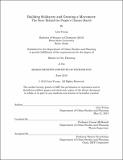| dc.contributor.advisor | Ceasar McDowell. | en_US |
| dc.contributor.author | Young, Lisa (Lisa Jean) | en_US |
| dc.contributor.other | Massachusetts Institute of Technology. Department of Urban Studies and Planning. | en_US |
| dc.date.accessioned | 2015-09-29T19:02:11Z | |
| dc.date.available | 2015-09-29T19:02:11Z | |
| dc.date.copyright | 2015 | en_US |
| dc.date.issued | 2015 | en_US |
| dc.identifier.uri | http://hdl.handle.net/1721.1/99083 | |
| dc.description | Thesis: M.C.P., Massachusetts Institute of Technology, Department of Urban Studies and Planning, 2015. | en_US |
| dc.description | Cataloged from studednt-submitted PDF version of thesis. | en_US |
| dc.description | Includes bibliographical references (pages 75-79). | en_US |
| dc.description.abstract | On September 21, 2014, 400,000 people converged on the streets of Manhattan for the People's Climate March (PCM), making it the largest climate change demonstration in U.S. history. Under a banner that read "Frontlines of Crisis, Forefront of Change," the march was led by low-income people of color and indigenous peoples -- those most affected by the health, environmental, and economic impacts of climate change and the broader fossil fuel industry. Never before had the social justice implications of climate change been given such prominence at a major U.S. climate protest, where environmental policy themes often dominate. This thesis tells the story of how these unique features of the PCM came to pass, as uncovered through literature research and interviews with core PCM organizers. By first tracing the history of the "climate movement" since the early 1990s, this research exposes a deep division between two streams of the movement -- the mainstream Climate Action (CA) camp, led by privileged white environmentalists, and the more radical Climate Justice (CJ) camp, led by frontline communities of color -- and reveals how the PCM arose from a timely and intentional planning partnership between the two. By directly addressing historically recurrent issues around trust, leadership, funding, framing, and strategy, the PCM planning team developed a collaborative framework that produced more equitable processes, sustained relationships, and just outcomes. As both arms of the climate movement acknowledge the simultaneous necessity and immense challenge of achieving deeper solidarity, the story of the PCM partnership shows that by engaging in shared work, CA and CJ groups may begin to dismantle the barriers that exist between them, grow the size and diversity of the climate movement, and rightfully lift up the voices of those that have long articulated bold calls for change from the frontlines of the climate crisis. | en_US |
| dc.description.statementofresponsibility | by Lisa Young. | en_US |
| dc.format.extent | 112 pages | en_US |
| dc.language.iso | eng | en_US |
| dc.publisher | Massachusetts Institute of Technology | en_US |
| dc.rights | M.I.T. theses are protected by copyright. They may be viewed from this source for any purpose, but reproduction or distribution in any format is prohibited without written permission. See provided URL for inquiries about permission. | en_US |
| dc.rights.uri | http://dspace.mit.edu/handle/1721.1/7582 | en_US |
| dc.subject | Urban Studies and Planning. | en_US |
| dc.title | Building solidarity and growing a movement : the story behind the People's Climate March | en_US |
| dc.title.alternative | Story behind the People's Climate March | en_US |
| dc.type | Thesis | en_US |
| dc.description.degree | M.C.P. | en_US |
| dc.contributor.department | Massachusetts Institute of Technology. Department of Urban Studies and Planning | |
| dc.identifier.oclc | 921891350 | en_US |
